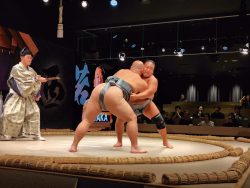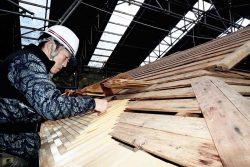
In the latter half of the Edo period, a kiseru long smoking pipe made of wood and metal, among other smoking tools, was a status symbol among the merchant class.
15:51 JST, March 23, 2021
The Showa Neon Takamura Kamban Museum has kept its lineup of antique kamban signboards arranged the same way ever since the day it opened. The signs dating from the Edo period (1603-1867) to the beginnings of the Showa era (1926-1989) model goods for sale with cryptic creatures and the occasional clumsy lettering that bring out a retro feel, giving visitors the chance to look back into the olden days of advertising.
Showa Neon, founded in 1922 as Takamura signage store, curates the exhibits for its museum in Shinagawa Ward, Tokyo. The company created the San-Ai Dream Center neon sign, among others, that’s positioned on top of a building at the glitzy Ginza 4-chome intersection. And in May it is set to celebrate 100 years of being open for business.
During his lifetime, third-generation President Goro Takamura used to take time off work and travel around the nation, collecting signs. By the time he passed away in November 2003, he had collected about 400 of them, believing that they were treasures from the past that represented the kamban artisans’ condensed knowledge and techniques.
Following in the footsteps of that belief, the fourth-generation president, Toru Takamura, chose about 180 of the signs and opened a museum for them in what was once a meeting room.

In the latter half of the Edo period, a kiseru long smoking pipe made of wood and metal, among other smoking tools, was a status symbol among the merchant class.
One of the signs features a long kiseru smoking pipe made of wood and metal that was once displayed in front of the Oroshisho Yazawa Fukuromono Ten (Wholesaler Yazawa Bag Store) during the Edo period. Kiseru were popular then and tobacco device shops were called bag stores. The merchant class was moving up in society at that time and many owned luxurious kiseru pipes as a way to be fashionable. Literacy levels were still relatively low among the general population and images on signs were highly favored over words.
Medical products were also promoted by using bold imagery mixed with cultural references. The museum has two rather unpleasant-looking wooden ogres wielding a massive club each and the words “medicine for a stomachache” are scrawled across their stomachs. The medicine’s name is inscribed on the clubs. A popular stomachache remedy in the Edo period was the dried gallbladder of a bear mixed with the dried roots of perennial daisy flowers. The totality of the cryptic imagery alludes to the Japanese “ogres using clubs” idiom, which means “adding power to something that’s already powerful” and customers are left to themselves to figure out what it might mean.
The museum also gives visitors the chance to look beyond signboards. On display is a mechanism that makes neon tubes glow. It has a roller with insulating bodies and copper sheets on it and it rotates with the same mechanisms as that of a music box. When a brush touches the copper sheet, it generates enough power to illuminate neon lights.
Even though advertising on the internet has become the most common practice nowadays, “stores will always need kamban signs,” said general affairs division chief Shoichi Okayasu. “People see them with their own eyes; they become part of the street. I think we can still find much use in kamban.”
Showa Neon Takamura Kamban Museum: Showa Neon Shinagawa Headquarters Building 2F, 1-7-17 Minami-Shinagawa, Shinagawa Ward, Tokyo.Related Tags
"Features" POPULAR ARTICLE
-

Students Recreate 19th-Century Bento Boxes Made for Ino Tadataka’s Survey Team in Hot Spring Town on Nakasendo Road
-

Santa Claus Delivers Christmas Presents to Penguins at Aquarium in Japan’s Nagasaki Prefecture
-

Sumo Restaurant in Tokyo Teaches Foreign Visitors About the Ancient Sport, with Bouts Between Retired Rikishi
-

Autonomous Passenger Ship Connects Mainland with Remote Island in Seto Inland Sea; World’s 1st Commercially Operated Autonomous Vessel
-

Osaka’s Sumiyoshi Taisha Shrine Bustles with New Year’s Visitors
JN ACCESS RANKING
-

As Chinese Tourists Shun Japan, Hotels and Stores Suffer
-

Osaka-Kansai Expo’s Economic Impact Estimated at ¥3.6 Trillion, Takes Actual Visitor Numbers into Account
-

Japan Govt Adopts Measures to Curb Mega Solar Power Plant Projects Amid Environmental Concerns
-

BOJ Gov. Ueda: Highly Likely Mechanism for Rising Wages, Prices Will Be Maintained
-

Economic Security Panels Debate Supply Chains, Rare Earths; Participants Emphasize Importance of Cooperation Among Allies

























